IMC Strategy & Buyer Behavior Analysis: Mini One 5-Door Case
VerifiedAdded on 2023/06/10
|25
|4834
|243
Report
AI Summary
This report provides a comprehensive analysis of buyer behavior and integrated marketing communication (IMC) strategies for the Mini One 5-door in Singapore. It begins with an introduction to Mini's company background, the product's features, and relevant market issues. The report then delves into a detailed analysis of the target market, including segmentation, profiling, and an examination of the degree of problem-solving (EPS) involved in the purchase decision. The consumer decision-making process is explored through the CDP model, covering problem recognition, information search, alternative assessment, purchase, and post-purchase behavior. Various internal and external influences on buyer behavior are also discussed. The report outlines an IMC strategy, including context analysis (PESTEL), communication goals (AIDA model), positioning strategy, creative strategy (emotional and rational appeals), marcom tools, media scheduling, and control and assessment methods. The overall goal is to provide a practical and actionable marketing plan for the Mini One 5-door in the Singaporean market, leveraging a deep understanding of consumer behavior and effective communication techniques. Desklib provides this assignment as a study resource, along with many other past papers and solved assignments.

BUYER BEHAVIOUR AND INTEGRATED MARKETING
COMMUNICATION
COMMUNICATION
Paraphrase This Document
Need a fresh take? Get an instant paraphrase of this document with our AI Paraphraser

Table of Contents
1.0 Introduction..........................................................................................................................3
1.1 Background of the company.............................................................................................3
1.2 Background of the product...............................................................................................3
1.3 Market issues....................................................................................................................3
2.0 Analysis of buyer’s behavior................................................................................................4
2.1 Target market....................................................................................................................4
2.2 Target market profile........................................................................................................4
2.3 Degree of problem-solving (EPS): Depending factors.....................................................5
2.4 CDP Model.......................................................................................................................5
2.5 Different influences..........................................................................................................8
3. IMC strategy...........................................................................................................................8
3.1 Context analysis................................................................................................................8
3.2 Communication goals.....................................................................................................12
3.3 Positioning strategy........................................................................................................13
3.4 Creative strategy.............................................................................................................14
3.5 Marcom tools..................................................................................................................15
3.6 Media scheduling............................................................................................................18
3.7 Control and Assessment.................................................................................................18
4. Conclusion............................................................................................................................20
Reference list............................................................................................................................21
1.0 Introduction..........................................................................................................................3
1.1 Background of the company.............................................................................................3
1.2 Background of the product...............................................................................................3
1.3 Market issues....................................................................................................................3
2.0 Analysis of buyer’s behavior................................................................................................4
2.1 Target market....................................................................................................................4
2.2 Target market profile........................................................................................................4
2.3 Degree of problem-solving (EPS): Depending factors.....................................................5
2.4 CDP Model.......................................................................................................................5
2.5 Different influences..........................................................................................................8
3. IMC strategy...........................................................................................................................8
3.1 Context analysis................................................................................................................8
3.2 Communication goals.....................................................................................................12
3.3 Positioning strategy........................................................................................................13
3.4 Creative strategy.............................................................................................................14
3.5 Marcom tools..................................................................................................................15
3.6 Media scheduling............................................................................................................18
3.7 Control and Assessment.................................................................................................18
4. Conclusion............................................................................................................................20
Reference list............................................................................................................................21
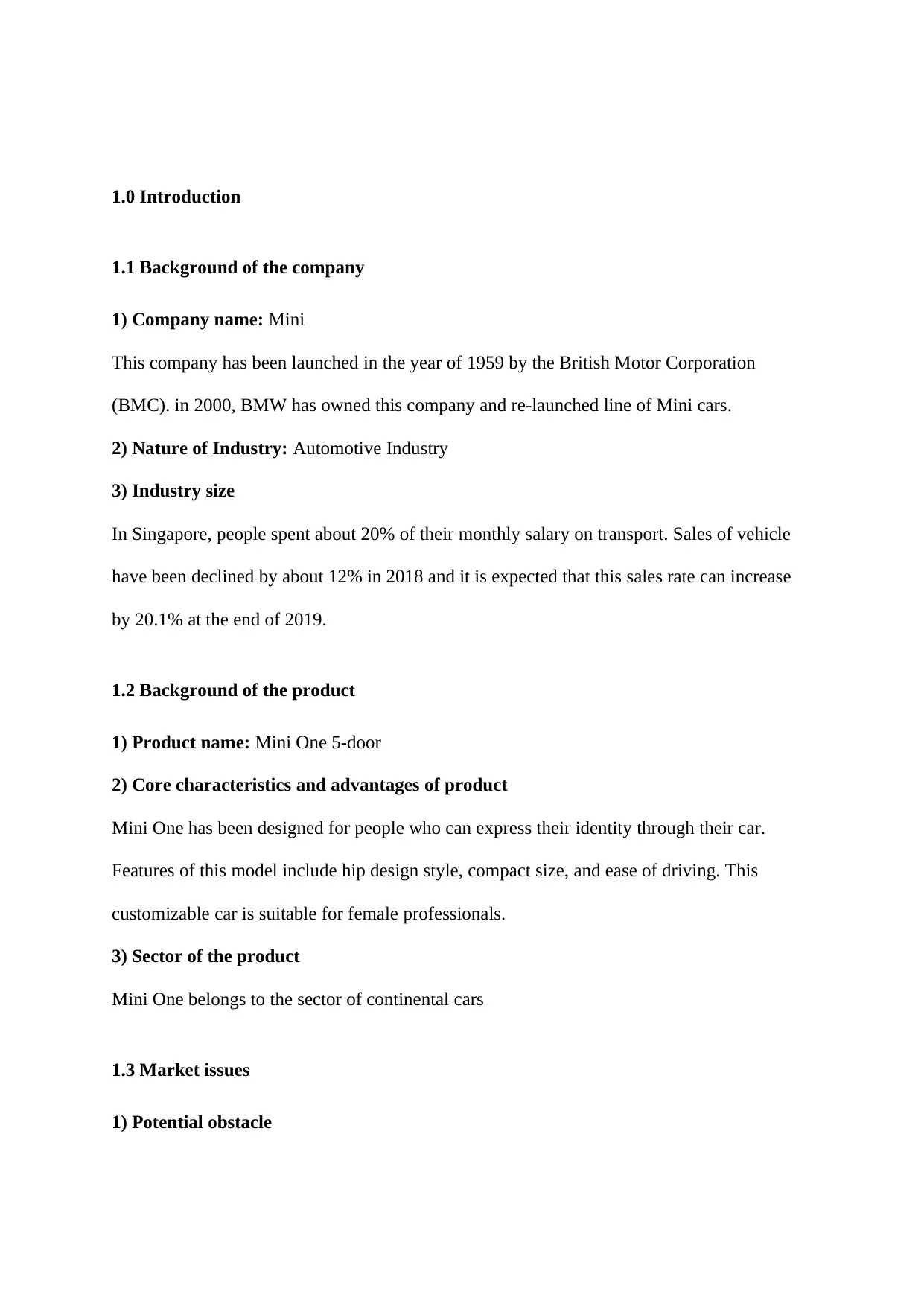
1.0 Introduction
1.1 Background of the company
1) Company name: Mini
This company has been launched in the year of 1959 by the British Motor Corporation
(BMC). in 2000, BMW has owned this company and re-launched line of Mini cars.
2) Nature of Industry: Automotive Industry
3) Industry size
In Singapore, people spent about 20% of their monthly salary on transport. Sales of vehicle
have been declined by about 12% in 2018 and it is expected that this sales rate can increase
by 20.1% at the end of 2019.
1.2 Background of the product
1) Product name: Mini One 5-door
2) Core characteristics and advantages of product
Mini One has been designed for people who can express their identity through their car.
Features of this model include hip design style, compact size, and ease of driving. This
customizable car is suitable for female professionals.
3) Sector of the product
Mini One belongs to the sector of continental cars
1.3 Market issues
1) Potential obstacle
1.1 Background of the company
1) Company name: Mini
This company has been launched in the year of 1959 by the British Motor Corporation
(BMC). in 2000, BMW has owned this company and re-launched line of Mini cars.
2) Nature of Industry: Automotive Industry
3) Industry size
In Singapore, people spent about 20% of their monthly salary on transport. Sales of vehicle
have been declined by about 12% in 2018 and it is expected that this sales rate can increase
by 20.1% at the end of 2019.
1.2 Background of the product
1) Product name: Mini One 5-door
2) Core characteristics and advantages of product
Mini One has been designed for people who can express their identity through their car.
Features of this model include hip design style, compact size, and ease of driving. This
customizable car is suitable for female professionals.
3) Sector of the product
Mini One belongs to the sector of continental cars
1.3 Market issues
1) Potential obstacle
⊘ This is a preview!⊘
Do you want full access?
Subscribe today to unlock all pages.

Trusted by 1+ million students worldwide
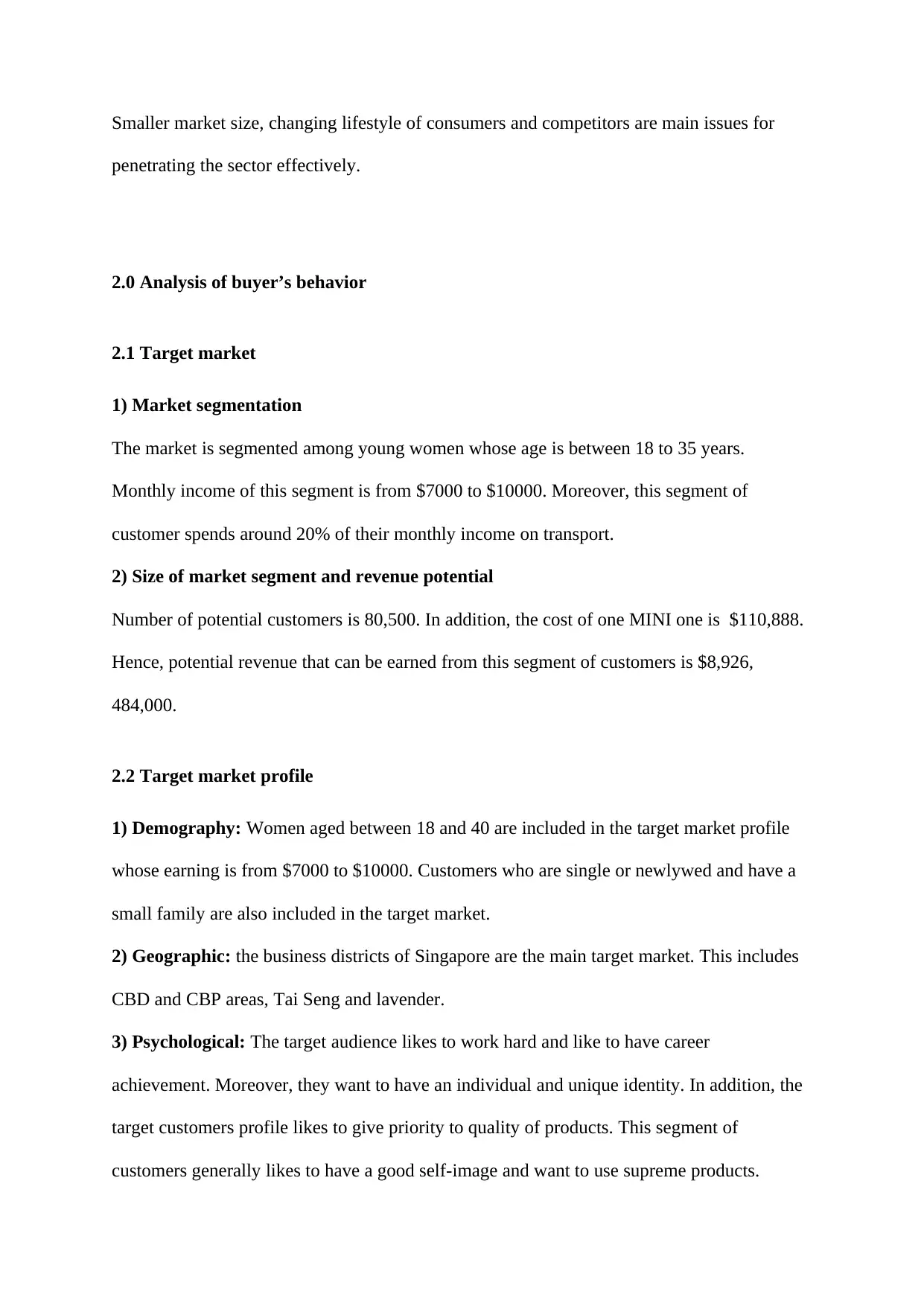
Smaller market size, changing lifestyle of consumers and competitors are main issues for
penetrating the sector effectively.
2.0 Analysis of buyer’s behavior
2.1 Target market
1) Market segmentation
The market is segmented among young women whose age is between 18 to 35 years.
Monthly income of this segment is from $7000 to $10000. Moreover, this segment of
customer spends around 20% of their monthly income on transport.
2) Size of market segment and revenue potential
Number of potential customers is 80,500. In addition, the cost of one MINI one is $110,888.
Hence, potential revenue that can be earned from this segment of customers is $8,926,
484,000.
2.2 Target market profile
1) Demography: Women aged between 18 and 40 are included in the target market profile
whose earning is from $7000 to $10000. Customers who are single or newlywed and have a
small family are also included in the target market.
2) Geographic: the business districts of Singapore are the main target market. This includes
CBD and CBP areas, Tai Seng and lavender.
3) Psychological: The target audience likes to work hard and like to have career
achievement. Moreover, they want to have an individual and unique identity. In addition, the
target customers profile likes to give priority to quality of products. This segment of
customers generally likes to have a good self-image and want to use supreme products.
penetrating the sector effectively.
2.0 Analysis of buyer’s behavior
2.1 Target market
1) Market segmentation
The market is segmented among young women whose age is between 18 to 35 years.
Monthly income of this segment is from $7000 to $10000. Moreover, this segment of
customer spends around 20% of their monthly income on transport.
2) Size of market segment and revenue potential
Number of potential customers is 80,500. In addition, the cost of one MINI one is $110,888.
Hence, potential revenue that can be earned from this segment of customers is $8,926,
484,000.
2.2 Target market profile
1) Demography: Women aged between 18 and 40 are included in the target market profile
whose earning is from $7000 to $10000. Customers who are single or newlywed and have a
small family are also included in the target market.
2) Geographic: the business districts of Singapore are the main target market. This includes
CBD and CBP areas, Tai Seng and lavender.
3) Psychological: The target audience likes to work hard and like to have career
achievement. Moreover, they want to have an individual and unique identity. In addition, the
target customers profile likes to give priority to quality of products. This segment of
customers generally likes to have a good self-image and want to use supreme products.
Paraphrase This Document
Need a fresh take? Get an instant paraphrase of this document with our AI Paraphraser
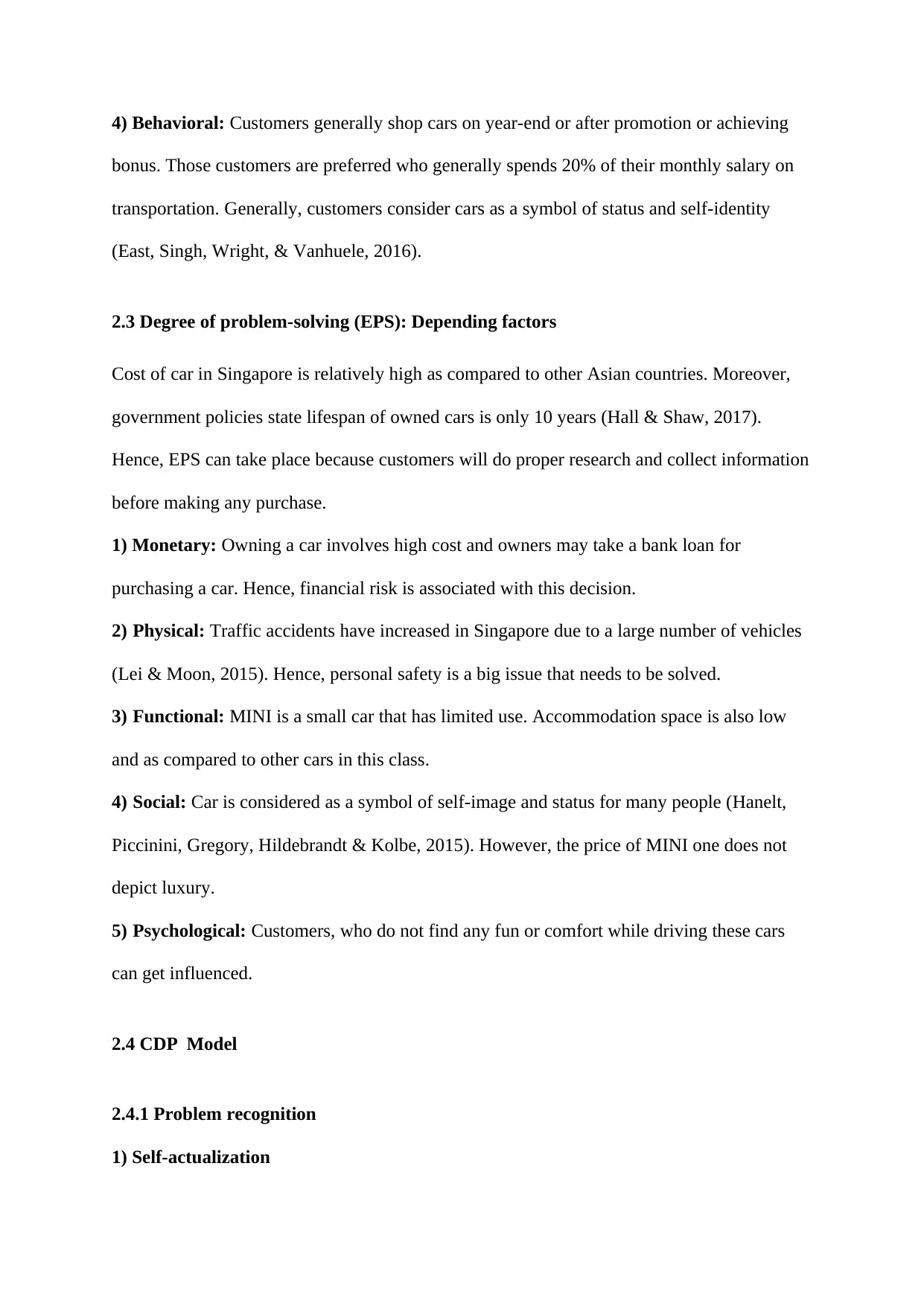
4) Behavioral: Customers generally shop cars on year-end or after promotion or achieving
bonus. Those customers are preferred who generally spends 20% of their monthly salary on
transportation. Generally, customers consider cars as a symbol of status and self-identity
(East, Singh, Wright, & Vanhuele, 2016).
2.3 Degree of problem-solving (EPS): Depending factors
Cost of car in Singapore is relatively high as compared to other Asian countries. Moreover,
government policies state lifespan of owned cars is only 10 years (Hall & Shaw, 2017).
Hence, EPS can take place because customers will do proper research and collect information
before making any purchase.
1) Monetary: Owning a car involves high cost and owners may take a bank loan for
purchasing a car. Hence, financial risk is associated with this decision.
2) Physical: Traffic accidents have increased in Singapore due to a large number of vehicles
(Lei & Moon, 2015). Hence, personal safety is a big issue that needs to be solved.
3) Functional: MINI is a small car that has limited use. Accommodation space is also low
and as compared to other cars in this class.
4) Social: Car is considered as a symbol of self-image and status for many people (Hanelt,
Piccinini, Gregory, Hildebrandt & Kolbe, 2015). However, the price of MINI one does not
depict luxury.
5) Psychological: Customers, who do not find any fun or comfort while driving these cars
can get influenced.
2.4 CDP Model
2.4.1 Problem recognition
1) Self-actualization
bonus. Those customers are preferred who generally spends 20% of their monthly salary on
transportation. Generally, customers consider cars as a symbol of status and self-identity
(East, Singh, Wright, & Vanhuele, 2016).
2.3 Degree of problem-solving (EPS): Depending factors
Cost of car in Singapore is relatively high as compared to other Asian countries. Moreover,
government policies state lifespan of owned cars is only 10 years (Hall & Shaw, 2017).
Hence, EPS can take place because customers will do proper research and collect information
before making any purchase.
1) Monetary: Owning a car involves high cost and owners may take a bank loan for
purchasing a car. Hence, financial risk is associated with this decision.
2) Physical: Traffic accidents have increased in Singapore due to a large number of vehicles
(Lei & Moon, 2015). Hence, personal safety is a big issue that needs to be solved.
3) Functional: MINI is a small car that has limited use. Accommodation space is also low
and as compared to other cars in this class.
4) Social: Car is considered as a symbol of self-image and status for many people (Hanelt,
Piccinini, Gregory, Hildebrandt & Kolbe, 2015). However, the price of MINI one does not
depict luxury.
5) Psychological: Customers, who do not find any fun or comfort while driving these cars
can get influenced.
2.4 CDP Model
2.4.1 Problem recognition
1) Self-actualization
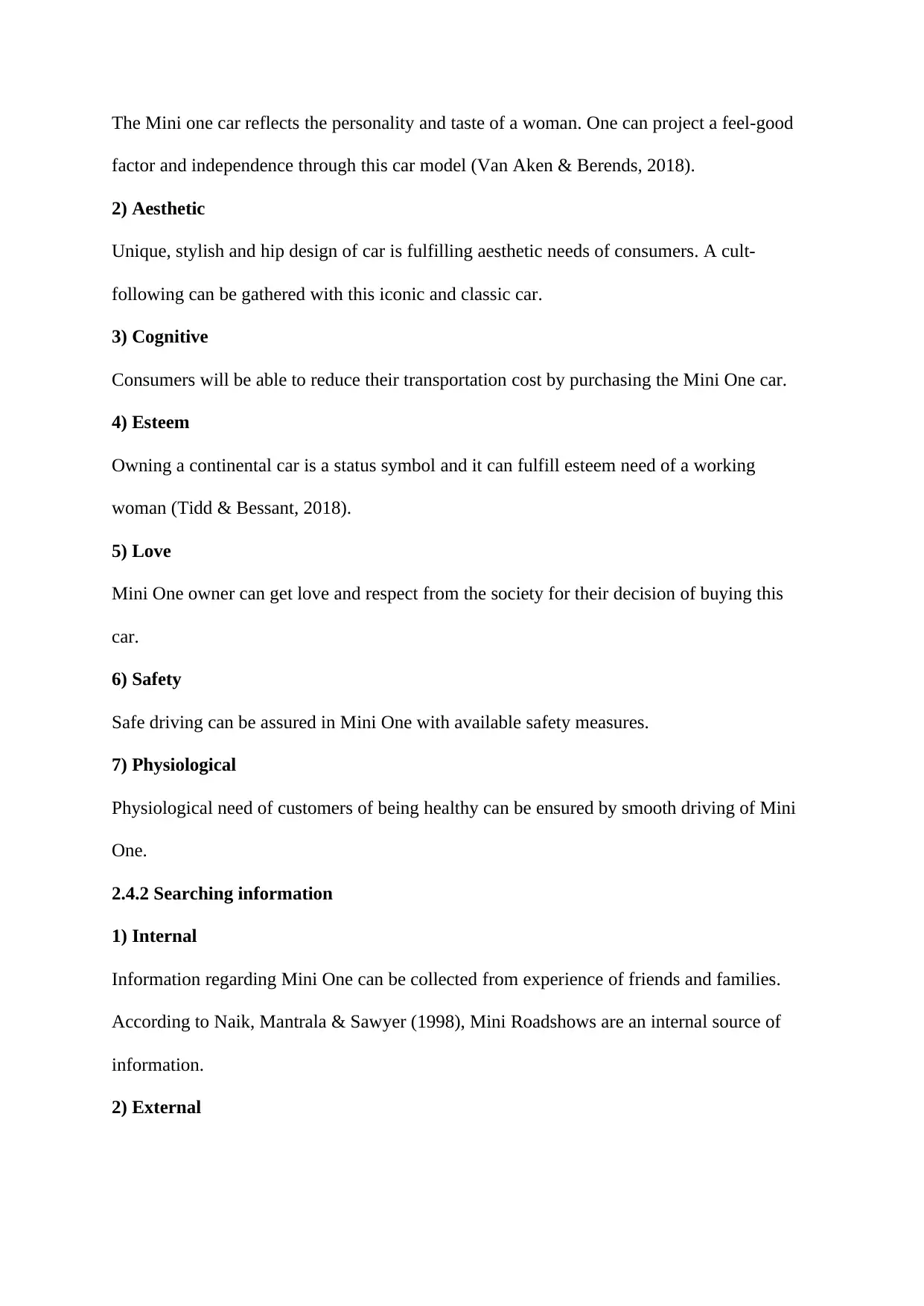
The Mini one car reflects the personality and taste of a woman. One can project a feel-good
factor and independence through this car model (Van Aken & Berends, 2018).
2) Aesthetic
Unique, stylish and hip design of car is fulfilling aesthetic needs of consumers. A cult-
following can be gathered with this iconic and classic car.
3) Cognitive
Consumers will be able to reduce their transportation cost by purchasing the Mini One car.
4) Esteem
Owning a continental car is a status symbol and it can fulfill esteem need of a working
woman (Tidd & Bessant, 2018).
5) Love
Mini One owner can get love and respect from the society for their decision of buying this
car.
6) Safety
Safe driving can be assured in Mini One with available safety measures.
7) Physiological
Physiological need of customers of being healthy can be ensured by smooth driving of Mini
One.
2.4.2 Searching information
1) Internal
Information regarding Mini One can be collected from experience of friends and families.
According to Naik, Mantrala & Sawyer (1998), Mini Roadshows are an internal source of
information.
2) External
factor and independence through this car model (Van Aken & Berends, 2018).
2) Aesthetic
Unique, stylish and hip design of car is fulfilling aesthetic needs of consumers. A cult-
following can be gathered with this iconic and classic car.
3) Cognitive
Consumers will be able to reduce their transportation cost by purchasing the Mini One car.
4) Esteem
Owning a continental car is a status symbol and it can fulfill esteem need of a working
woman (Tidd & Bessant, 2018).
5) Love
Mini One owner can get love and respect from the society for their decision of buying this
car.
6) Safety
Safe driving can be assured in Mini One with available safety measures.
7) Physiological
Physiological need of customers of being healthy can be ensured by smooth driving of Mini
One.
2.4.2 Searching information
1) Internal
Information regarding Mini One can be collected from experience of friends and families.
According to Naik, Mantrala & Sawyer (1998), Mini Roadshows are an internal source of
information.
2) External
⊘ This is a preview!⊘
Do you want full access?
Subscribe today to unlock all pages.

Trusted by 1+ million students worldwide
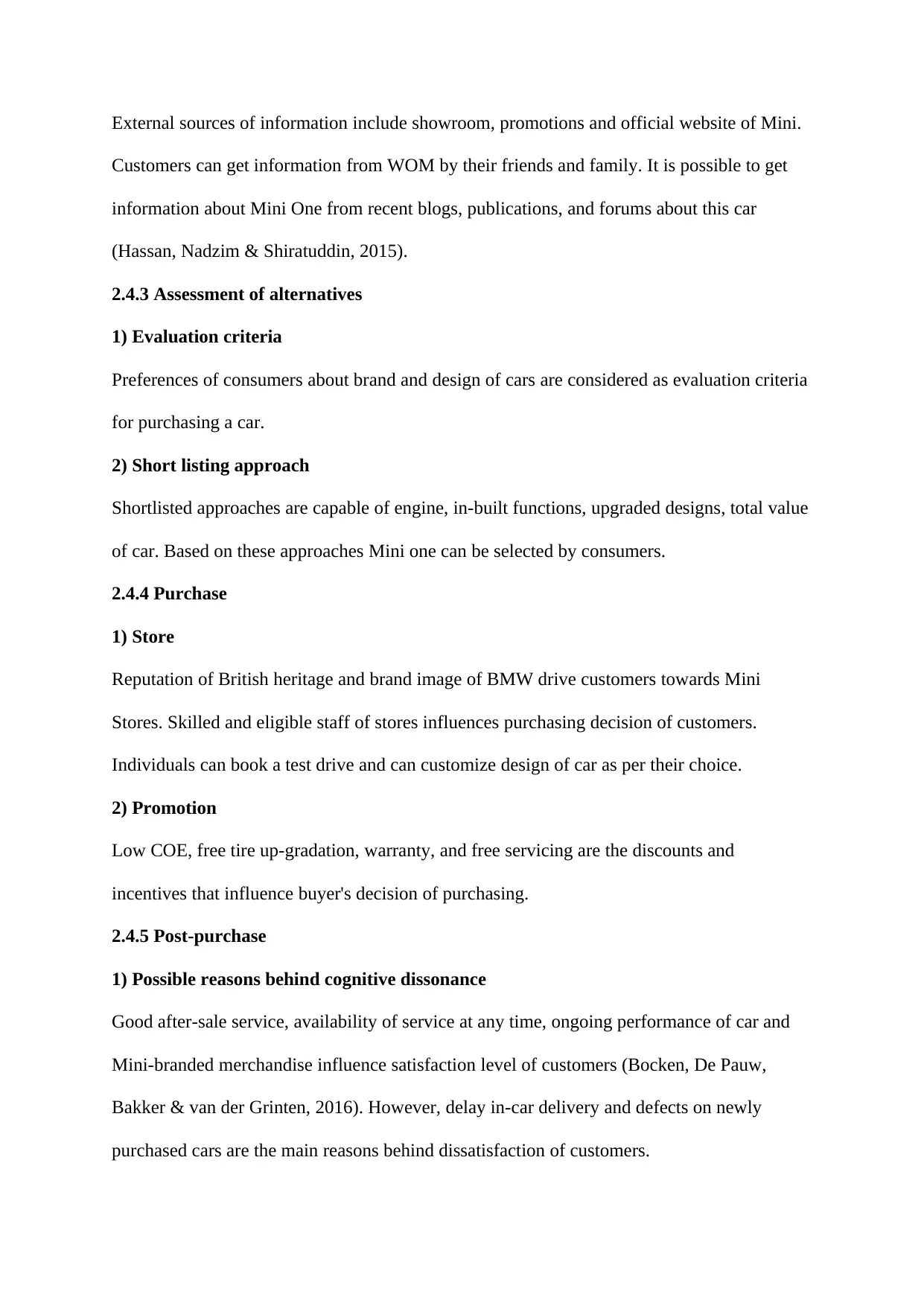
External sources of information include showroom, promotions and official website of Mini.
Customers can get information from WOM by their friends and family. It is possible to get
information about Mini One from recent blogs, publications, and forums about this car
(Hassan, Nadzim & Shiratuddin, 2015).
2.4.3 Assessment of alternatives
1) Evaluation criteria
Preferences of consumers about brand and design of cars are considered as evaluation criteria
for purchasing a car.
2) Short listing approach
Shortlisted approaches are capable of engine, in-built functions, upgraded designs, total value
of car. Based on these approaches Mini one can be selected by consumers.
2.4.4 Purchase
1) Store
Reputation of British heritage and brand image of BMW drive customers towards Mini
Stores. Skilled and eligible staff of stores influences purchasing decision of customers.
Individuals can book a test drive and can customize design of car as per their choice.
2) Promotion
Low COE, free tire up-gradation, warranty, and free servicing are the discounts and
incentives that influence buyer's decision of purchasing.
2.4.5 Post-purchase
1) Possible reasons behind cognitive dissonance
Good after-sale service, availability of service at any time, ongoing performance of car and
Mini-branded merchandise influence satisfaction level of customers (Bocken, De Pauw,
Bakker & van der Grinten, 2016). However, delay in-car delivery and defects on newly
purchased cars are the main reasons behind dissatisfaction of customers.
Customers can get information from WOM by their friends and family. It is possible to get
information about Mini One from recent blogs, publications, and forums about this car
(Hassan, Nadzim & Shiratuddin, 2015).
2.4.3 Assessment of alternatives
1) Evaluation criteria
Preferences of consumers about brand and design of cars are considered as evaluation criteria
for purchasing a car.
2) Short listing approach
Shortlisted approaches are capable of engine, in-built functions, upgraded designs, total value
of car. Based on these approaches Mini one can be selected by consumers.
2.4.4 Purchase
1) Store
Reputation of British heritage and brand image of BMW drive customers towards Mini
Stores. Skilled and eligible staff of stores influences purchasing decision of customers.
Individuals can book a test drive and can customize design of car as per their choice.
2) Promotion
Low COE, free tire up-gradation, warranty, and free servicing are the discounts and
incentives that influence buyer's decision of purchasing.
2.4.5 Post-purchase
1) Possible reasons behind cognitive dissonance
Good after-sale service, availability of service at any time, ongoing performance of car and
Mini-branded merchandise influence satisfaction level of customers (Bocken, De Pauw,
Bakker & van der Grinten, 2016). However, delay in-car delivery and defects on newly
purchased cars are the main reasons behind dissatisfaction of customers.
Paraphrase This Document
Need a fresh take? Get an instant paraphrase of this document with our AI Paraphraser

2) Consumption
Working women are target customers of Mini One and they own this car when they have
monthly income of minimum $7000 and above. This car can help them to show their social
class while going to work and returning from work by driving this car.
3) Divestment
Consumers may keep driving Mini One by maintaining good condition of car. Regular
servicing and tire upgradation are required for disposing of their social status with this car.
2.5 Different influences
1) External: Reference group is considered as an influence that includes celebrities who
drive MINIone and other achievers. These people can motivate common customers who
follow them and consider them as an idol (Bellos, Ferguson & Toktay, 2017). Social class is
another external influence because choice of car depicts the social status of a person. As
owning a car is expensive in Singapore, therefore buying a MINIone can represent the social
status of the owner.
2) Internal: Motivation is an internal factor that includes self-concept. Type of car a person
drives represents the taste and personality of that person (Hadiyati, 2016).
2.6. Key issue regarding processing of information
There are some issues that impact on information processing of customers. For MINIone
attention is the major issue that impacts on consumer information processing. As opined by
Lee & Hoffman (2015), attention is very crucial for reaching to customers on a cognitive
level. This can be done through product design, advertisements, and other appeals. The
attractive design of MINIone and external influence like reference group can motivate
customers to process information. Attractive design, beautiful colors and comparatively low
Working women are target customers of Mini One and they own this car when they have
monthly income of minimum $7000 and above. This car can help them to show their social
class while going to work and returning from work by driving this car.
3) Divestment
Consumers may keep driving Mini One by maintaining good condition of car. Regular
servicing and tire upgradation are required for disposing of their social status with this car.
2.5 Different influences
1) External: Reference group is considered as an influence that includes celebrities who
drive MINIone and other achievers. These people can motivate common customers who
follow them and consider them as an idol (Bellos, Ferguson & Toktay, 2017). Social class is
another external influence because choice of car depicts the social status of a person. As
owning a car is expensive in Singapore, therefore buying a MINIone can represent the social
status of the owner.
2) Internal: Motivation is an internal factor that includes self-concept. Type of car a person
drives represents the taste and personality of that person (Hadiyati, 2016).
2.6. Key issue regarding processing of information
There are some issues that impact on information processing of customers. For MINIone
attention is the major issue that impacts on consumer information processing. As opined by
Lee & Hoffman (2015), attention is very crucial for reaching to customers on a cognitive
level. This can be done through product design, advertisements, and other appeals. The
attractive design of MINIone and external influence like reference group can motivate
customers to process information. Attractive design, beautiful colors and comparatively low

price can attract target customers and motivate them to collect and process information about
the product.
3. IMC strategy
3.1 Context analysis
3.1.1 External content
PESTEL factor Opportunity/threat IMC implication
Economic High per capita income of
Singapore in ASEAN can
increase purchasing ability
of customers.
Social networking
Economic factor of pestle impacts in revenue rate of the company. Increase in per capita
income of the country impacts on purchasing ability of customers (Kushwaha & Sharma,
2016). Per capita income of Singapore is high as compared to other ASEAN countries. As an
IMC approach, social media marketing can be done to gain customers.
3.1.2 Business context
Key attributes of products Benefits to the campaign IMC implication
Design of MINIone The design can facilitate
multitasker women
PR
the product.
3. IMC strategy
3.1 Context analysis
3.1.1 External content
PESTEL factor Opportunity/threat IMC implication
Economic High per capita income of
Singapore in ASEAN can
increase purchasing ability
of customers.
Social networking
Economic factor of pestle impacts in revenue rate of the company. Increase in per capita
income of the country impacts on purchasing ability of customers (Kushwaha & Sharma,
2016). Per capita income of Singapore is high as compared to other ASEAN countries. As an
IMC approach, social media marketing can be done to gain customers.
3.1.2 Business context
Key attributes of products Benefits to the campaign IMC implication
Design of MINIone The design can facilitate
multitasker women
PR
⊘ This is a preview!⊘
Do you want full access?
Subscribe today to unlock all pages.

Trusted by 1+ million students worldwide
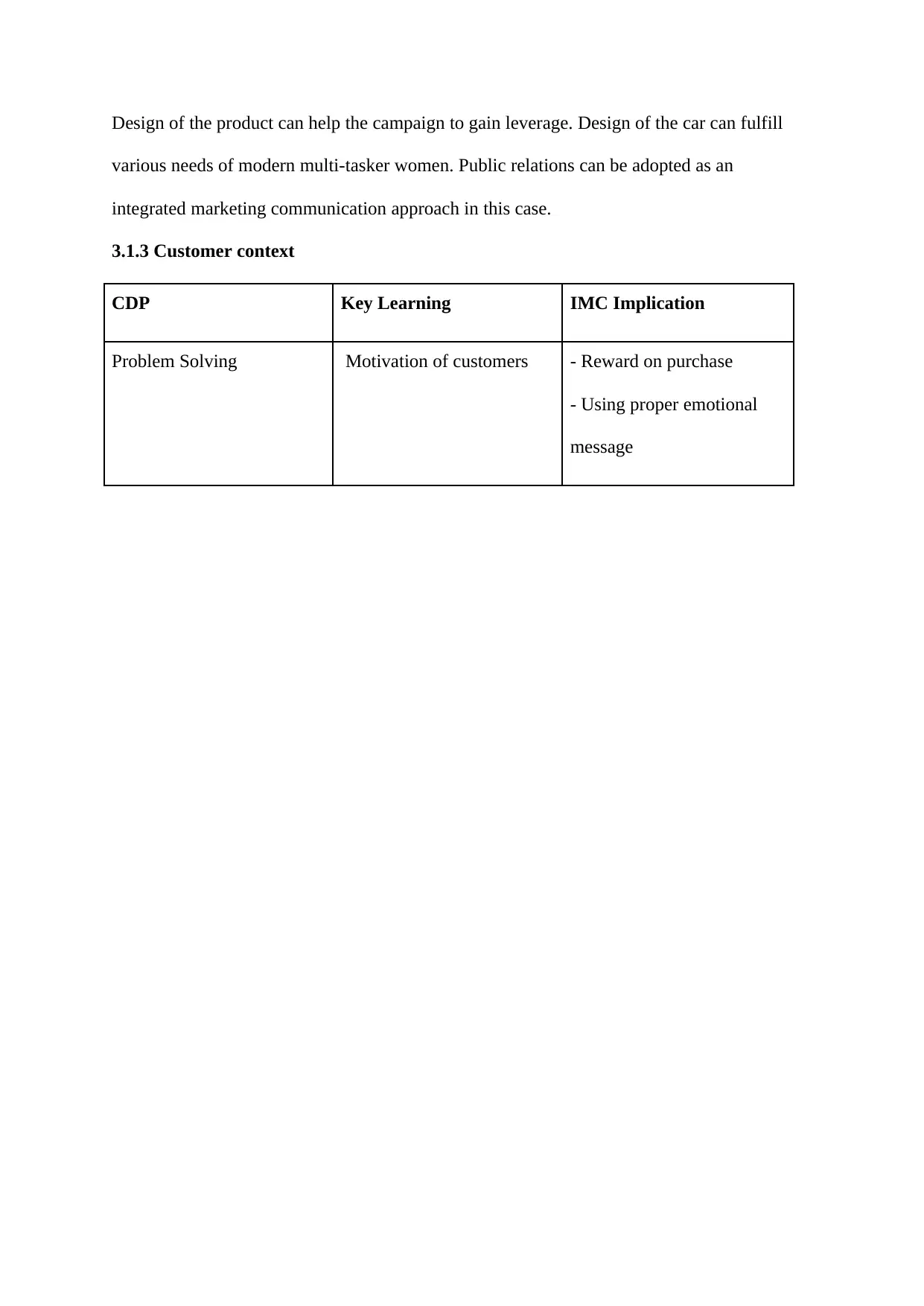
Design of the product can help the campaign to gain leverage. Design of the car can fulfill
various needs of modern multi-tasker women. Public relations can be adopted as an
integrated marketing communication approach in this case.
3.1.3 Customer context
CDP Key Learning IMC Implication
Problem Solving Motivation of customers - Reward on purchase
- Using proper emotional
message
various needs of modern multi-tasker women. Public relations can be adopted as an
integrated marketing communication approach in this case.
3.1.3 Customer context
CDP Key Learning IMC Implication
Problem Solving Motivation of customers - Reward on purchase
- Using proper emotional
message
Paraphrase This Document
Need a fresh take? Get an instant paraphrase of this document with our AI Paraphraser
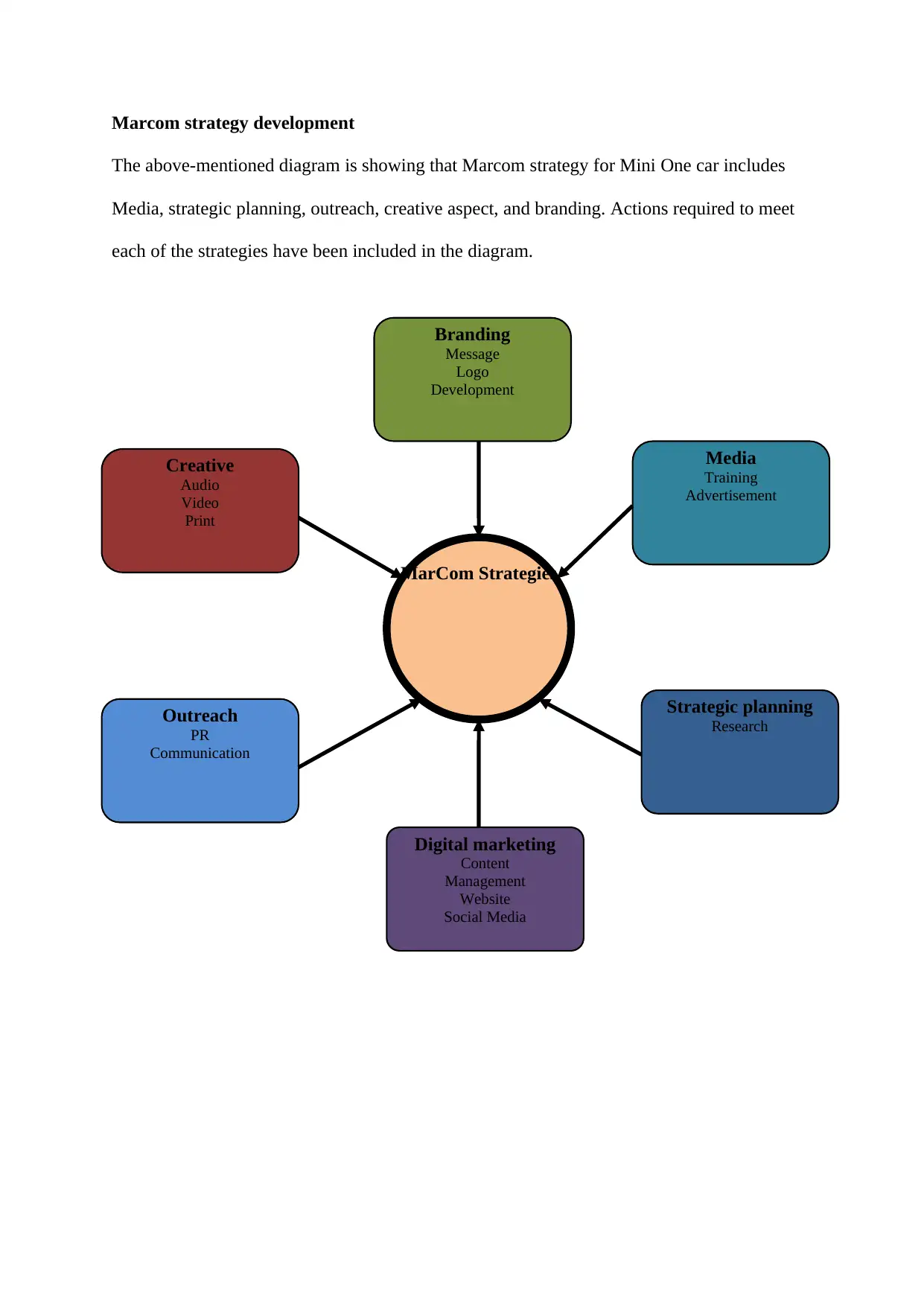
MarCom Strategies
Strategic planning
Research
Outreach
PR
Communication
Creative
Audio
Video
Print
Media
Training
Advertisement
Branding
Message
Logo
Development
Digital marketing
Content
Management
Website
Social Media
Marcom strategy development
The above-mentioned diagram is showing that Marcom strategy for Mini One car includes
Media, strategic planning, outreach, creative aspect, and branding. Actions required to meet
each of the strategies have been included in the diagram.
Strategic planning
Research
Outreach
PR
Communication
Creative
Audio
Video
Media
Training
Advertisement
Branding
Message
Logo
Development
Digital marketing
Content
Management
Website
Social Media
Marcom strategy development
The above-mentioned diagram is showing that Marcom strategy for Mini One car includes
Media, strategic planning, outreach, creative aspect, and branding. Actions required to meet
each of the strategies have been included in the diagram.
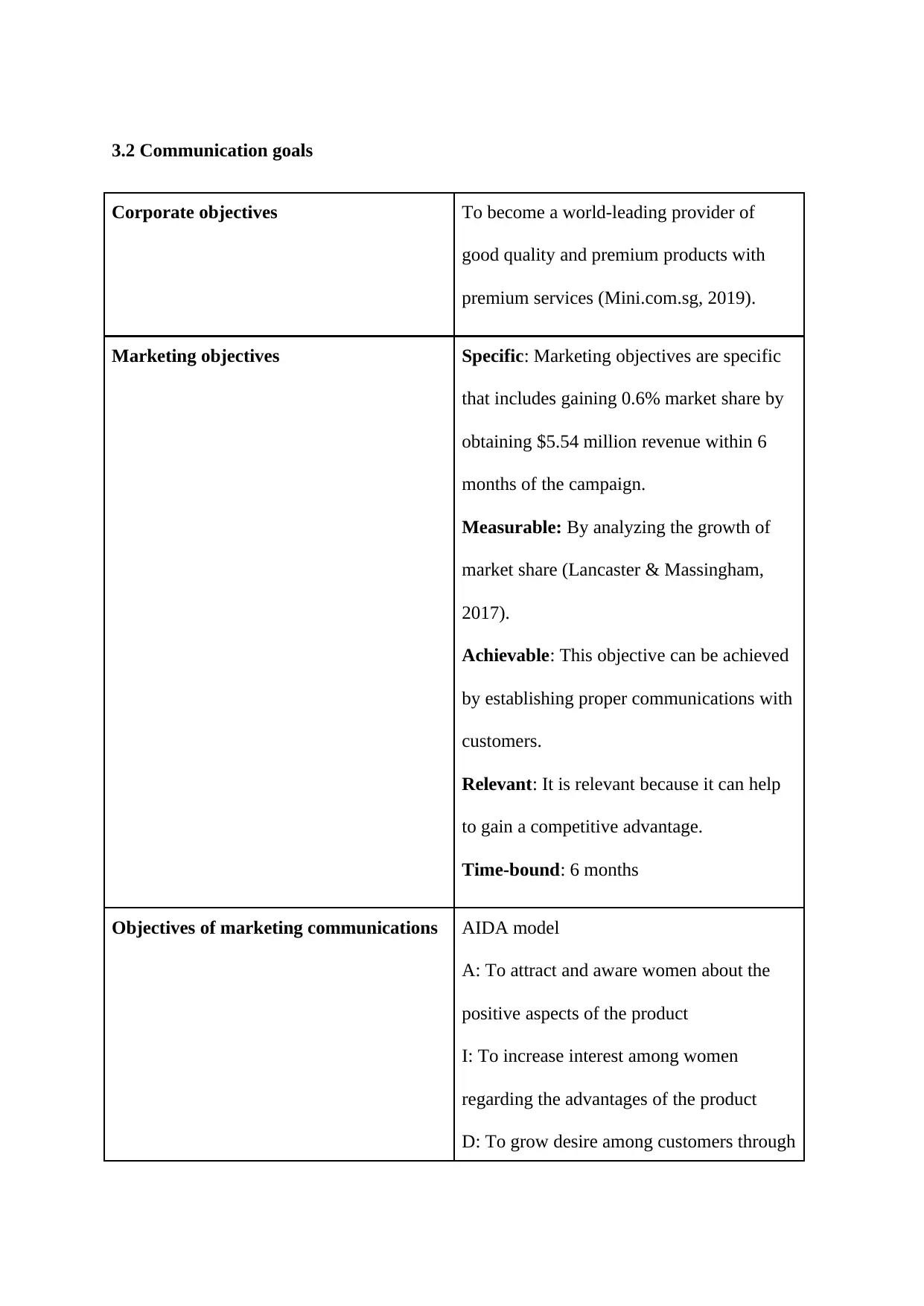
3.2 Communication goals
Corporate objectives To become a world-leading provider of
good quality and premium products with
premium services (Mini.com.sg, 2019).
Marketing objectives Specific: Marketing objectives are specific
that includes gaining 0.6% market share by
obtaining $5.54 million revenue within 6
months of the campaign.
Measurable: By analyzing the growth of
market share (Lancaster & Massingham,
2017).
Achievable: This objective can be achieved
by establishing proper communications with
customers.
Relevant: It is relevant because it can help
to gain a competitive advantage.
Time-bound: 6 months
Objectives of marketing communications AIDA model
A: To attract and aware women about the
positive aspects of the product
I: To increase interest among women
regarding the advantages of the product
D: To grow desire among customers through
Corporate objectives To become a world-leading provider of
good quality and premium products with
premium services (Mini.com.sg, 2019).
Marketing objectives Specific: Marketing objectives are specific
that includes gaining 0.6% market share by
obtaining $5.54 million revenue within 6
months of the campaign.
Measurable: By analyzing the growth of
market share (Lancaster & Massingham,
2017).
Achievable: This objective can be achieved
by establishing proper communications with
customers.
Relevant: It is relevant because it can help
to gain a competitive advantage.
Time-bound: 6 months
Objectives of marketing communications AIDA model
A: To attract and aware women about the
positive aspects of the product
I: To increase interest among women
regarding the advantages of the product
D: To grow desire among customers through
⊘ This is a preview!⊘
Do you want full access?
Subscribe today to unlock all pages.

Trusted by 1+ million students worldwide
1 out of 25
Related Documents
Your All-in-One AI-Powered Toolkit for Academic Success.
+13062052269
info@desklib.com
Available 24*7 on WhatsApp / Email
![[object Object]](/_next/static/media/star-bottom.7253800d.svg)
Unlock your academic potential
Copyright © 2020–2025 A2Z Services. All Rights Reserved. Developed and managed by ZUCOL.





